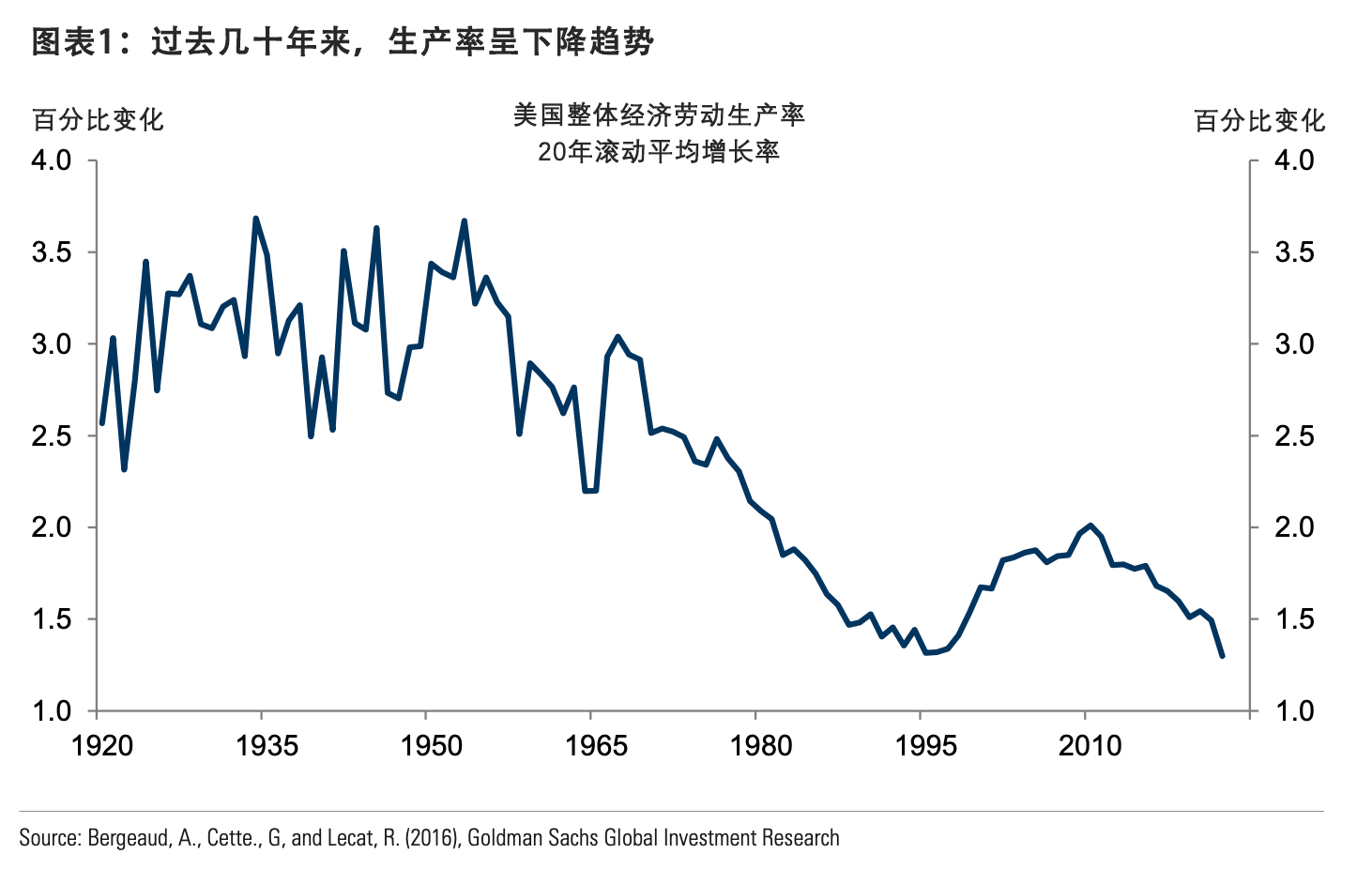
不难发现,白领首席执行官对弹性工作制时代哀叹不已,坚称在办公室以外任何地方工作的员工都注意力不集中、工作效率低下,这通常会导致财务业绩不佳。高盛集团(Goldman Sachs)的苏德巍(David Solomon)长期以来一直坚称,任何表现出灵活性的姿态都是“反常现象”。摩根大通(JPMorgan Chase)的杰米·戴蒙坚持认为,远程工作者能够在其他地方工作,而亚马逊(Amazon)的安迪·贾西告诫那些反对办公室办公的员工,如果他们不改弦更张,事情“很可能对你不利”。此外,贾西补充道,几乎所有大公司的首席执行官都同意他的观点。
学术界甚至华尔街的一些顶级经济学家都表示,实际上,也许这太严苛了。纽约大学(New York University)的经济学家托马斯·菲利蓬在2022年发表的一篇广为流传的论文中指出,可以说,自工业革命以来,现代劳动力一直在缓慢但持续地拖沓不前。这归结为一个名为“全要素生产率”(TFP)的概念,它描述了一个公司或国家在不增加劳动力或资本的情况下所能够实现的增长。换句话说,要聪明高效地开展工作,而不是埋头苦干。
高盛集团的首席经济学家简·哈祖斯领导的团队最近撰写的一份报告支持了菲利蓬的说法,指出在过去五年里,生产率增长要么停滞,要么有所下降。但这并不是因为远程工作、高管快速变更或其他任何现代困境。分析师们写道:“趋势生产率增长往往会随着时间的推移而下降。”
由于更新和更先进的技术,生产力并没有呈指数级增长,而是逐渐趋于平稳。根据高盛集团的说法,慢滴模型而不是指数模型“有助于在一定程度上解释过去15年生产率增长相对于长期历史平均水平表现不佳的原因,但不能完全解释这一现象。”如果上述表述属实,将是巨大发现,因为菲利蓬研究了数百年的数据,可以追溯到工业革命(Industrial Revolution)后不久的1890年。
综上所述,老板们是否会改变他们对面对面工作优点的看法呢?
生产率悖论不仅仅是关于在哪里工作或使用什么技术
菲利蓬认为,几十年来,人们一直认为全要素生产率会随着人类创造力的增长呈指数级增长,但与这一沿用了几十年的假设相反,它实际上是呈线性增长的。他确实研究了可以追溯到数百年前的数据,即英国从1600年到1914年的全要素生产率数据和美国从1890年到现在的全要素生产率数据。如果这一表述属实,这既是好消息,也是坏消息。
好消息是,与大多数经济学家所看到的创新急剧下降的警告不同,全要素生产率的缓慢增长更像是一切照旧。只要全要素生产率的年增量保持在高位,高管们就没有理由为低增长率感到恐慌,也没有理由把责任归咎于任何现代趋势,比如工作灵活性或跳槽。当然,坏消息是,几百年来,经济一直在缓慢增长,没有出现过几次爆炸性增长。
高盛集团的分析师们倾向于同意这一观点。他们补充道,除了维持现有水平外,员工们的生产率实际上正在放缓。他们写道:“全要素生产率的历史平均增长率并不是对未来全要素生产率增长的正确基准预期——这太过乐观了。相反,我们应该预期全要素生产率的增长会随着时间的推移而放缓。”他们说,这在一定程度上解释了过去15年生产率增长表现不佳的原因。

他们写道,生成式人工智能实际上可能会推翻菲利蓬的论点,并指出采用人工智能带来的生产率提高“足以抵消未来10年至20年的潜在增长放缓”。不过,哈祖斯警告称,这“有可能实现,但为时尚早”。
许多在工作场所施加影响力并投入大量资金支持人工智能的老板当然希望这一表述属实。如果他们认为员工只是工作干劲不足,那就更希望这一表述属实了。根据安永-博智隆(EY-Parthenon)的研究和美国劳工统计局(Bureau of Labor Statistics)的数据,今年早些时候,美国经历了自1948年以来首次连续五个季度生产率同比下降。安永-博智隆的首席经济学家格雷戈里·达科当时告诉《财富》杂志,生产率下降的部分原因是远程工作,但并非全部原因。他说:“我们从各行各业的客户那里听到了类似的故事:新工作环境导致生产率下降。”
但是,人们的工作时间也更长(这意味着劳动力利用率更高),而工作成果却几乎没有增加,这就导致了整体生产率的下降。
达科表示:“当产出增速超过劳动力增速时,那这样的环境就能够提高生产率。如果情况正好相反,即产出增长缓慢,但劳动力增长强劲,那这样的环境就会导致生产率低下。”
如果生成式人工智能确实能提高生成率呢?
高盛集团的哈祖斯指出了菲利蓬论点中的一个缺陷,从而给自己留出了一些回旋余地:全要素生产率没有呈指数增长,并不意味着它必须呈线性增长。他同意菲利蓬的观点,即“像电力这样对经济产生广泛影响的变革性新技术”不时出现,并带来新的生产率快速增长期。
达科提出的另一个导致生产率下降的原因是极高的人员变更率和流失率。由于“大辞职潮”(Great Resignation)和“安静辞职”的持续影响,许多员工在短期工作后就离开了工作岗位,缺乏忠诚度。达科指出:“因为人们跳槽太频繁了,所以实际上没有机会把他们提升到以前员工所能够达到的工作速度或生产率。”
尽管如此,“远程工作和弹性工作制的整体理念是让人们提高生成率。”为此,智库经济学人影响力(Economist Impact)最近的一份报告发现,弹性工作制实际上并不是员工注意力不集中的罪魁祸首,实际上是员工缺乏选择和“蓬勃发展的工作场所的基础设施薄弱”。
因此,即使混合型工作模式经受住了时间的考验,倾向于办公室工作的员工也可能获得更丰厚的回报。“如果就业市场放缓,我们可能就会看到更多的人支持在办公室工作三天到四天,而不是一两天。”达科在今年5月表示。
对于那些长期以来一直认为自己居家办公工作效率一样高(即使没有更高)的员工来说,这可能是一个不受欢迎的消息。但菲利蓬的研究结果,加上高盛集团的报告,应该会让人感到宽慰,并对支持办公室工作的老板提出有力反驳:自从伊莱·惠特尼首次推出轧棉机以来,人类的生产力一直在逐渐下降——即使人工智能发展迅速,为什么这种情况现在会发生改变呢?(财富中文网)
译者:中慧言-王芳
不难发现,白领首席执行官对弹性工作制时代哀叹不已,坚称在办公室以外任何地方工作的员工都注意力不集中、工作效率低下,这通常会导致财务业绩不佳。高盛集团(Goldman Sachs)的苏德巍(David Solomon)长期以来一直坚称,任何表现出灵活性的姿态都是“反常现象”。摩根大通(JPMorgan Chase)的杰米·戴蒙坚持认为,远程工作者能够在其他地方工作,而亚马逊(Amazon)的安迪·贾西告诫那些反对办公室办公的员工,如果他们不改弦更张,事情“很可能对你不利”。此外,贾西补充道,几乎所有大公司的首席执行官都同意他的观点。
学术界甚至华尔街的一些顶级经济学家都表示,实际上,也许这太严苛了。纽约大学(New York University)的经济学家托马斯·菲利蓬在2022年发表的一篇广为流传的论文中指出,可以说,自工业革命以来,现代劳动力一直在缓慢但持续地拖沓不前。这归结为一个名为“全要素生产率”(TFP)的概念,它描述了一个公司或国家在不增加劳动力或资本的情况下所能够实现的增长。换句话说,要聪明高效地开展工作,而不是埋头苦干。
高盛集团的首席经济学家简·哈祖斯领导的团队最近撰写的一份报告支持了菲利蓬的说法,指出在过去五年里,生产率增长要么停滞,要么有所下降。但这并不是因为远程工作、高管快速变更或其他任何现代困境。分析师们写道:“趋势生产率增长往往会随着时间的推移而下降。”
由于更新和更先进的技术,生产力并没有呈指数级增长,而是逐渐趋于平稳。根据高盛集团的说法,慢滴模型而不是指数模型“有助于在一定程度上解释过去15年生产率增长相对于长期历史平均水平表现不佳的原因,但不能完全解释这一现象。”如果上述表述属实,将是巨大发现,因为菲利蓬研究了数百年的数据,可以追溯到工业革命(Industrial Revolution)后不久的1890年。
综上所述,老板们是否会改变他们对面对面工作优点的看法呢?
生产率悖论不仅仅是关于在哪里工作或使用什么技术
菲利蓬认为,几十年来,人们一直认为全要素生产率会随着人类创造力的增长呈指数级增长,但与这一沿用了几十年的假设相反,它实际上是呈线性增长的。他确实研究了可以追溯到数百年前的数据,即英国从1600年到1914年的全要素生产率数据和美国从1890年到现在的全要素生产率数据。如果这一表述属实,这既是好消息,也是坏消息。
好消息是,与大多数经济学家所看到的创新急剧下降的警告不同,全要素生产率的缓慢增长更像是一切照旧。只要全要素生产率的年增量保持在高位,高管们就没有理由为低增长率感到恐慌,也没有理由把责任归咎于任何现代趋势,比如工作灵活性或跳槽。当然,坏消息是,几百年来,经济一直在缓慢增长,没有出现过几次爆炸性增长。
高盛集团的分析师们倾向于同意这一观点。他们补充道,除了维持现有水平外,员工们的生产率实际上正在放缓。他们写道:“全要素生产率的历史平均增长率并不是对未来全要素生产率增长的正确基准预期——这太过乐观了。相反,我们应该预期全要素生产率的增长会随着时间的推移而放缓。”他们说,这在一定程度上解释了过去15年生产率增长表现不佳的原因。
他们写道,生成式人工智能实际上可能会推翻菲利蓬的论点,并指出采用人工智能带来的生产率提高“足以抵消未来10年至20年的潜在增长放缓”。不过,哈祖斯警告称,这“有可能实现,但为时尚早”。
许多在工作场所施加影响力并投入大量资金支持人工智能的老板当然希望这一表述属实。如果他们认为员工只是工作干劲不足,那就更希望这一表述属实了。根据安永-博智隆(EY-Parthenon)的研究和美国劳工统计局(Bureau of Labor Statistics)的数据,今年早些时候,美国经历了自1948年以来首次连续五个季度生产率同比下降。安永-博智隆的首席经济学家格雷戈里·达科当时告诉《财富》杂志,生产率下降的部分原因是远程工作,但并非全部原因。他说:“我们从各行各业的客户那里听到了类似的故事:新工作环境导致生产率下降。”
但是,人们的工作时间也更长(这意味着劳动力利用率更高),而工作成果却几乎没有增加,这就导致了整体生产率的下降。
达科表示:“当产出增速超过劳动力增速时,那这样的环境就能够提高生产率。如果情况正好相反,即产出增长缓慢,但劳动力增长强劲,那这样的环境就会导致生产率低下。”
如果生成式人工智能确实能提高生成率呢?
高盛集团的哈祖斯指出了菲利蓬论点中的一个缺陷,从而给自己留出了一些回旋余地:全要素生产率没有呈指数增长,并不意味着它必须呈线性增长。他同意菲利蓬的观点,即“像电力这样对经济产生广泛影响的变革性新技术”不时出现,并带来新的生产率快速增长期。
达科提出的另一个导致生产率下降的原因是极高的人员变更率和流失率。由于“大辞职潮”(Great Resignation)和“安静辞职”的持续影响,许多员工在短期工作后就离开了工作岗位,缺乏忠诚度。达科指出:“因为人们跳槽太频繁了,所以实际上没有机会把他们提升到以前员工所能够达到的工作速度或生产率。”
尽管如此,“远程工作和弹性工作制的整体理念是让人们提高生成率。”为此,智库经济学人影响力(Economist Impact)最近的一份报告发现,弹性工作制实际上并不是员工注意力不集中的罪魁祸首,实际上是员工缺乏选择和“蓬勃发展的工作场所的基础设施薄弱”。
因此,即使混合型工作模式经受住了时间的考验,倾向于办公室工作的员工也可能获得更丰厚的回报。“如果就业市场放缓,我们可能就会看到更多的人支持在办公室工作三天到四天,而不是一两天。”达科在今年5月表示。
对于那些长期以来一直认为自己居家办公工作效率一样高(即使没有更高)的员工来说,这可能是一个不受欢迎的消息。但菲利蓬的研究结果,加上高盛集团的报告,应该会让人感到宽慰,并对支持办公室工作的老板提出有力反驳:自从伊莱·惠特尼首次推出轧棉机以来,人类的生产力一直在逐渐下降——即使人工智能发展迅速,为什么这种情况现在会发生改变呢?(财富中文网)
译者:中慧言-王芳
It isn’t hard to find a white collar CEO bemoaning the flexible work era, insisting that workers located anywhere but the office are less focused, less productive, and generally the reason for any sub-par financial results. Goldman Sachs’ David Solomon has long insisted that any gesture towards flexibility is an “aberration.” JPMorgan Chase’s Jamie Dimon insists remote workers can simply work elsewhere, and Amazon’s Andy Jassy cautioned anti-office workers that things “probably won’t work out for you” if they don’t change their tune. Plus, Jassy added, almost all large company CEOs agree with him.
Some of the top economists in academia and even Wall Street are saying that actually, maybe that’s too harsh. Thomas Philippon, an economist at New York University, argued in a widely read 2022 paper that the modern workforce has been dragging its feet, so to speak, on a slow but continuous basis since the Industrial Revolution. It comes down to a concept called “total factor productivity,” which describes the growth a company or nation can attain without adding to their labor force or capital. In other words, working smarter, not harder.
A recent Goldman Sachs report, written by a team led by chief economist Jan Hatzius, throws support to Philippon’s claim, pointing out that productivity growth has either stalled or dropped over the past five years. No, it’s not because of remote work, or rapid executive turnover, or any other modern plight. “Trend productivity growth simply tends to fall over time,” the analysts wrote.
Rather than productivity growing exponentially thanks to newer and more cutting-edge technologies, things actually tend to gradually even off. Per Goldman, the slow drip model rather than the exponential model “helps to explain some but not all of the underperformance of productivity growth over the last 15 years relative to the long-term historical average.” This is the ultimate big, if true, because Philippon looked at hundreds of years of data, going back to 1890, shortly after the Industrial Revolution.
All of this being said, will bosses change their tune on the merits of in-person work?
The productivity paradox is about way more than where you work—or with what tech
Philippon argues that contrary to the decades-old assumption that total factor productivity (TFP) grows exponentially as human ingenuity expands, it actually grows linearly. He literally looked at data going back hundreds of years, using British TFP data from 1600 to 1914 and American data of TFP from 1890 to the present. If true, this is both good and bad news.
The good news is that the sputtering growth rate of TFP, instead of the warning of plummeting innovation that most economists see, is more like business as usual. As long as annual increments of TFP remain high, slow growth rates are no reason for executives to panic, or cast blame on any modern trend, like work flexibility or job hopping. The bad news, of course, is that the economy has been trickling along for literally hundreds of years, absent a few big bangs.
Goldman analysts tend to agree. And, they add: just remaining level, workers are actually slowing down. “The historical average rate of TFP growth is not the right baseline expectation for future TFP growth—it is too optimistic,” they write. “Instead, we should expect TFP growth to slow over time.” That, they say, helps partly explain the past 15 years of underperforming productivity growth.
Generative AI could actually throw a wrench into Philippon’s argument, they write, noting that the productivity gains stemming from AI adoption “could more than offset the underlying growth slowdown over the next 10-20 years.” Still, Hatzius cautions that this is “possible but very premature.”
Many bosses who are throwing their weight—and dollars—behind AI adoption in their workplaces would certainly hope that’s true. Doubly so if they believe workers are simply working less hard. Earlier this year, per EY-Parthenon research and Bureau of Labor Statistics data, the U.S. underwent five consecutive quarters of year-over-year productivity declines for the first time since 1948. Gregory Daco, chief economist for EY-Parthenon, told Fortune at the time that the productivity drop stemmed partly from remote work—but not entirely. “From our clients across sectors, we hear similar stories of reduced productivity because of the new work environment,” he said.
But people were also working longer hours (which means higher labor utilization) while barely putting out more work product, which shakes out to reduced productivity overall.
“When you have an environment in which output is outpacing labor growth, that’s an environment of stronger productivity,” Daco said. “When you have the opposite, when output growth is sluggish but labor growth is strong, you have a weak productivity environment.”
What if generative AI is the real deal?
Goldman’s Hatzius gives himself some wiggle room by noting a flaw in Philippon’s argument: That just because TFP does not grow exponentially, that doesn’t mean it has to grow linearly instead. He agrees with Philippon that “new transformative technologies with wide-ranging effects on the economy like electricity” have come along from time and time and ushered in new periods of faster productivity growth.
Another reason Daco offered for productivity dropping substantial turnover and churn; as a lingering impact of the Great Resignation and quiet quitting, many workers have taken to leaving their jobs after short spells, feeling no sense of loyalty. “Because people were job-hopping so regularly, there wasn’t really a chance to bring them up to the speed, or productivity, that a former worker would’ve had,” Daco said.
Nonetheless, “the whole idea of remote work and flexible work is to allow people to be more productive.” To that end, a recent report from think tank Economist Impact found that flexible work actually isn’t to blame for workers losing focus—it’s actually a lack of employee choice and “weak infrastructure for a thriving workplace.”
So even if a hybrid arrangement stands the test of time, the workers who gravitate towards the office are likely to reap the most rewards. “We’ll probably see more weight towards three to four days in the office, rather than one or two, if the labor market slows,” Daco said in May.
That’s probably unwelcome news to workers who have long maintained that they’re just as productive—if not more productive—at home. But Philippon’s findings, bolstered by Goldman Sachs’s note, should provide a solid source of comfort, and a strong rebuttal to a pro-office boss: Humans have been becoming gradually less productive since Eli Whitney debuted the cotton gin—why, even with rapidly advancing AI, would that change now?






